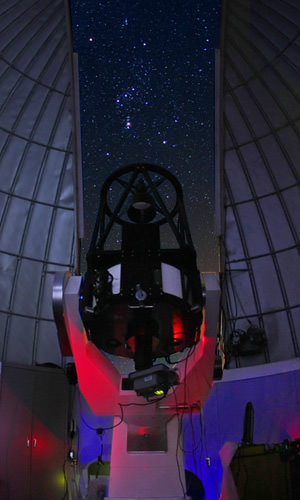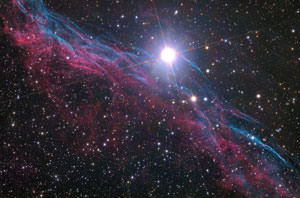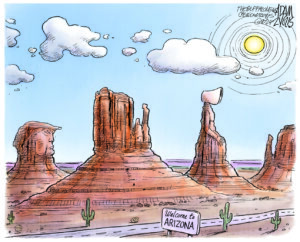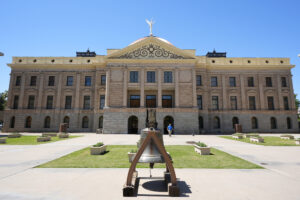Riding the Milky Way in Tucson
A couple of days after I arrived in Tucson, there came a party invitation The public was invited to the top of Mount Lemmon for a viewing of the annual Perseid showers, a breathtaking display of shooting stars While I generally brake for sand, I also hit the road for star parties.
For insight into various mysteries, I often consult a circle of advisers. This includes not just the usual round of consultants — friends, relatives living and not — but Joshua trees, astrological charts, the weather channel and long-gone saints, sinners and prophets. When I really need to get to the heart of things, I turn to one more source — the animal oracle belonging to a certain ancient tribe (can’t say which one; not to sound cryptic but a girl’s gotta keep a few secrets). This oracle comes in the form of a deck of cards, each emblazoned with an animal that represents particular traits, associations and lessons. Over the years, I’ve checked in with this deck many times; invariably its insight is accurate and powerful. Recently, I began contemplating a move from Los Angeles to various places in the Southwest. One of those locations is Tucson — to the dismay of certain friends who are bypassing the entire state of Arizona because of recent developments in immigration policy. For me, politics does not determine things in the long run; it’s the land — what it promises, what it looks like and how it stirs my spirit. Although I had visited Tucson several times and always liked it, I wanted to see what was hiding behind the saguaros (what I have long called “the Charlton Heston of cacti,” as opposed to the misunderstood and less glamorous Joshua tree — long a totem for me). So that’s how I came to ask the cards what they could tell me about Tucson. The answer was startling and beautiful, shedding light on the region in a time when its everlasting qualities are overlooked in favor of heated political discussion. But more important, everywhere I went during a Tucson visit, the answer was confirmed in palpable echoes of the card that I drew upon posing my fateful question.
In general, it had to do with stars. And I’m not referring to celebrities. No, I speak of what twinkled unnamed and unreachable long before the birth of Hollywood — and in fact was reminded of such during a visit from my mother as we were driving into Tinseltown years ago to see some sights.
|
Stars are the crucibles in which almost all elements heavier than hydrogen and helium are formed. If it were not for their deaths, these elements would never be released into the galaxy. Our own Sun formed from a gas cloud that was infused with trace amounts of these elements which later formed into planets and people. We are star stuff. We are made of the same material shown in these beautiful ribbons of color which are the result of the dramatic death of a star through a supernova explosion. The Veil Nebula lies some 1,400 light years away in the direction of Cygnus. Photo and caption by Adam Block / Mount Lemmon SkyCenter / University of Arizona |
There on the corner of Hollywood and Vine was a man with a sign that said “star maps.” Various tourists approached him and purchased his wares. “How nice,” my mother said as she watched. “People are buying maps of the constellations.” Well, what can I tell you? She’s from Ohio, a land where “star maps” really would be maps of the constellations. But I’m from Ohio too, though I had lived in L.A. long enough to know that there was little if any interest there, among tourists at least, not to mention countless other citizens everywhere, in maps of the heavens. It was with great disappointment that I explained people were buying addresses of the rich and famous, complete with triangulations if you paid a few dollars more. My mother and I shared a laugh — at the silliness of it all, as well as the nature of her question. Although she had been living in New York for ages, you can’t really take the girl out of the Buckeye State — a land that has no guile, although sometimes, during pancake festivals, there’s a certain sophistication when the servers break out the family silver.
Shortly after the trip to Hollywood and Vine, my mother’s question got me to thinking about the strange L.A. cottage industry of men who stand at street corners and peddle “star maps,” weird almanacs that take latter-day wanderers to Lindsay Lohan’s house rather than the Big Dipper. How far we have come from ancient times when we connected to the infinite through the primordial; we adore celebrities, stars who walk among us and leave a trail of glitter and dust. In their fame, they become immortal, and in our attachment to them we too have life everlasting.
I was never entranced by the famous, except for Clint Eastwood, to whom I literally could not speak, feeling as if I were in the presence of a supernova, when a mutual friend introduced me to him at a restaurant some time ago. I had had a crush on Clint ever since he was Rowdy Yates in “Rawhide” (hasn’t every girl had a “Rowdy” in her life?), and for days afterwards, I remained in a fevered state, convinced that we had had a moment because we made eye contact and he shook my hand. I began looking into whether any of the local star maps provided his address; they didn’t and I retreated to my corner, pondering the strange spiral I had fallen into. Soon I reminded myself that Hollywood made everything weird. As always, I headed to the desert for solace, refocusing my attention on what was missing in my life. Whenever I visited Joshua Tree National Park, Death Valley and other preferred spots, I found myself more deeply engaged with nonhuman stars, tracking celestial events with a bona fide star map that I ordered from an observatory. My father had shown me Orion’s Belt when I was little and that I remembered, and of course I knew all about Ursa Major and Minor; now I planted myself facing north, south, east or west, learned the names and positions of other constellations, and hitched my wagon to these new destinations. The notion that human luminaries can take us to the infinite quickly faded, even as an ironic observation, and I was right back in Ohio again, swept away by the night skies and riding with Pegasus. A couple of days after I arrived in Tucson, there came a party invitation. The public was invited to the top of Mount Lemmon for a viewing of the annual Perseid showers, a breathtaking display of shooting stars that is not visible to people in urban areas and outlying areas due to light pollution. While I generally brake for sand, I also hit the road for star parties; without hesitation I made the one-hour drive up the winding Catalina Highway through the Coronado National Forest to the Sky Center on top of the mountain. I was told to arrive promptly at 4:30 p.m., lest I miss entry through the observatory gates, so I did not make my customary stops at scenic overlooks — except for one whose call I could not resist. It turned out that this one provided a view of the place where my love affair with the West began long ago — New Mexico.
Delighted with this omen and sending a shout-out to the Land of Enchantment, I continued my journey to the observatory, arriving on time and joining a small party of pilgrims who had gathered outside the gates. There at the summit was a guy with long hair on a purple motorcycle, wearing a Sons of Anarchy T-shirt. I asked him if he worked on the television show of that title and he said that he was in an actual club with that name; I later checked and there is one — its members are military veterans. As we continued chatting, it turned out that we both were fans of the terrestrial star Katey Sagal, the biker mom on the TV show. “Are you here for the protests?” he said upon learning that I lived in California. “People are protesting meteors?” I said, so in the moment that I had forgotten about the turmoil in the lower ethers. “No,” he said, “it’s prop — ” and I immediately knew that he was referring to Arizona’s new immigration policy. “I’m just here for the stars,” I said, and happily shook hands with our host and guide, Adam Block, the noted University of Arizona astronomer who had just arrived to kick off the party.
Opening the gates, Adam led us along a trail to a compound of giant telescopes at an elevation of 9,200 feet, the uppermost point on this “sky island” region of Arizona — one of various forested mountain ranges surrounded by grassland and desert flats across the Sonoran plains. Home to screech owls, bear, and clumping lady bugs that love the mountaintop and gather in droves across the compound, Mount Lemmon was named for botanist Sarah Lemmon, who trekked to the top in 1881 on mules and foot with Native American guides. Several years later, the Indian wars would conclude, with the capture of Geronimo in Douglas, Ariz.; in the Dragoon Mountains to the southeast — also part of the Coronado National Forest — the Apache chief Cochise lies buried, in a secret location. “Why shut me up on a reservation?” Cochise once said. “We will make peace. We will keep it faithfully. But let us go around free as Americans do. Let us go wherever we please.”
From the rim of Mount Lemmon, with the naked eye, you could see a few sparkling stars in the fading sunlight, and with the telescopes that we were about to look through, there would be what Adam called “access to the universe” — what Native Americans saw as they looked skyward long ago in the selfsame mountain terrain.
After the sun went down, we followed Adam across the grounds toward a conference room. On the valley floor the temperature was 90 degrees, but on top of Mount Lemmon it was a cool 60 and dropping. Inside the Sky Center, Adam gave a talk as we waited for the night skies to present their treasure. An impassioned observer of the skies and renowned photographer of stars, galaxies and nebulae, he offered a quick and wide-ranging grounding in celestial matters. First, he unveiled a satellite image of Arizona. It was mostly covered in red. For star-gazing that was good. “The views tonight will be better than what most of humanity gets,” he said. “By the way, does anyone know why stars twinkle?” Apparently not. “Stars twinkle because Earth’s atmosphere disrupts light.” When it was fully dark, we repaired to one of the giant telescopes and the show began.
There was Jupiter with all its bands and Saturn with its rings. There were old stars, shimmering sheets of dust, and what Adam called “stellar nurseries” — countless new stars that would enter the universe when conditions were right, clustered in pockets across the heavens. There was the Horsehead Nebula, the summer triangle — featuring the blue-white Vega, Deneb (the brightest star in the constellation Cygnus, the swan) and Altair; Venus and Mercury too, appearing as a thin silver crescent in a cloud. “Look,” Adam said. “There are the twin stars of Leda. Those are the stars that Poe mentioned in his story ‘Ligeia.’ ” This was a girl with whom Poe was obsessed. He couldn’t get over her eyes, describing them as “shining, divine orbs” that were his “twin stars of Leda,” rendering him “the devoutest of astrologers.” A Poe connection at the top of Mount Lemmon was indeed big news! Those who are familiar with my work will know that his poem “Eldorado” was pivotal in my life, essentially bringing me west by way of my father many years ago. Now Poe was bringing me to the stars, and I vowed to revisit the master as soon as I descended the mountain. Yet other delights were in store. Our space odyssey continued and a mix of meditative techno sounds played in the background, and then our very own galaxy came into view — the Milky Way in all its splendor, the glittering and endless expanse that is our home and does not have borders. And this was the thing that kicked Tucson into a new category for me.
You see, the card that I had drawn when I asked my original question was the cow. Cow represents nourishment, healing and protection. And she is associated with the Milky Way, a trail of bounty or mother’s milk, a celestial echo of ancient cattle paths which connected towns and cities. Many times had I seen the Milky Way (or eaten it; I was addicted to the eponymous candy bar in college), but never before in a particular context, as an answer to an urgent question. Perhaps the card explained why so many people head toward the region, in spite of great hardship along the way.
Around midnight it was time for the Perseid showers, and I joined everyone else as we positioned ourselves outside with binoculars and star maps provided by the Sky Center. Each of us was assigned a particular constellation to watch for meteors passing through. Shortly after midnight they began their dance, and I saw one that left a really long trail blast through Cepheus in the northern sky.
As we waited for more starbursts, there came one more piece of significant information. Adam pointed out Sagittarius with his laser. “See the teapot at the center?” he said. “That’s the center of our galaxy.” A teapot is the center of the Milky Way? This was like the Monopoly card “bank makes mistake in your favor” and combined with all of the other news that had come my way, it was all a big score.
Later, as I made my way down the mountain under the twinkling sky, I heard the rumble of Harley pipes, and I thought about the guy in the Sons of Anarchy T-shirt and his long hair flowing as he flew across the night road. And then I remembered something I learned in California, an ancient Shoshone belief, that hair was considered sacred, a connection to the ethers. Perhaps when their own hair was stirred by a desert breeze, they felt an attachment to something greater than themselves. Often, they mimicked the link in their sand paintings; with human hair, they made ropes that ran from the middle of the painting to the four directions, tying the soul to the wind and beyond.
Stars too were another connection to immortality. The Shoshone believed that the twinkling illuminations were souls of the dead, and that if you gazed at the Milky Way, you could follow the path that souls traveled, and connect with the ancestors forever. And that’s what I did at the top of Mount Lemmon as I read the star maps, crossing all borders and finding a new home — or at least a place where I could rest easy for a while, until the Joshua trees called me back from the saguaros with their siren Mojave song.
Deanne Stillman’s latest book is the widely acclaimed “Mustang: The Saga of the Wild Horse in the American West,” a Los Angeles Times “Best Book ’08” and winner of the California Book Award silver medal for nonfiction. Her book includes an account of the 1998 Christmas horse massacre outside Reno, as well as the story of Bugz, the lone survivor of the incident. Her work appears in the L.A. Times, Slate, Orion and other publications and is widely anthologized. Her plays, including “Star Maps,” have won prizes in theater festivals around the country. She is currently writing “Mojave Manhunt” for Nation Books, based on her Rolling Stone piece of the same name. Follow Deanne Stillman on Facebook.
Your support matters…Independent journalism is under threat and overshadowed by heavily funded mainstream media.
You can help level the playing field. Become a member.
Your tax-deductible contribution keeps us digging beneath the headlines to give you thought-provoking, investigative reporting and analysis that unearths what's really happening- without compromise.
Give today to support our courageous, independent journalists.







You need to be a supporter to comment.
There are currently no responses to this article.
Be the first to respond.